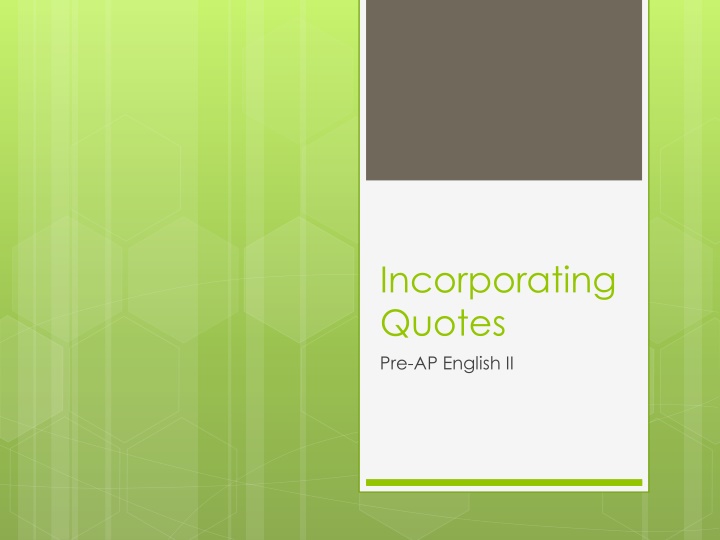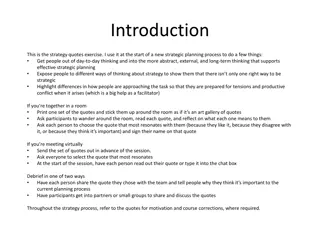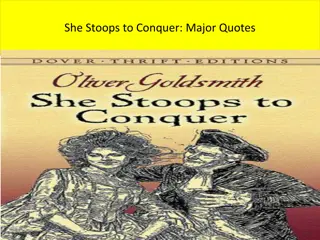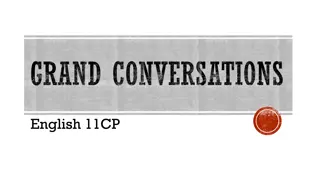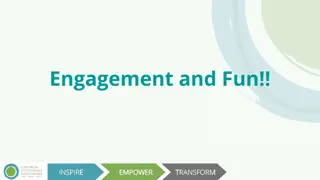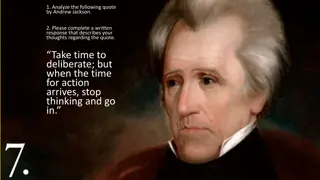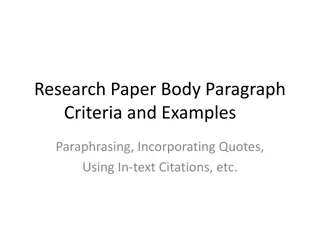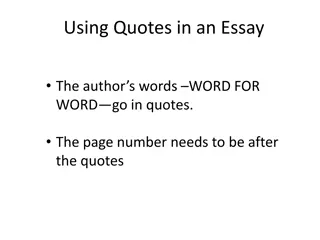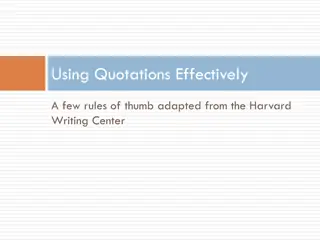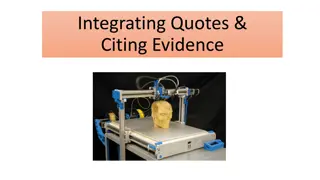Effective Methods for Incorporating Quotes in Pre-AP English II
Learn different techniques for effectively incorporating quotes in Pre-AP English II essays. Explore methods like using a natural continuation of thought, a colon before the quote, and attributing quotes using synonyms with examples from the novella "Of Mice and Men" by John Steinbeck.
Download Presentation

Please find below an Image/Link to download the presentation.
The content on the website is provided AS IS for your information and personal use only. It may not be sold, licensed, or shared on other websites without obtaining consent from the author.If you encounter any issues during the download, it is possible that the publisher has removed the file from their server.
You are allowed to download the files provided on this website for personal or commercial use, subject to the condition that they are used lawfully. All files are the property of their respective owners.
The content on the website is provided AS IS for your information and personal use only. It may not be sold, licensed, or shared on other websites without obtaining consent from the author.
E N D
Presentation Transcript
Incorporating Quotes Pre-AP English II
The following excerpt comes from the novella Of Mice and Men by John Steinbeck: Original Quote: I ought to have shot that dog myself, George, I shouldn t ought to have let no stranger shoot my dog Snippet of quote: I ought to have shot that dog myself (Steinbeck 27).
Method C (Someone Said) Formula: Synonym of said + comma + quote This is the least effective of all the methods. In essence, you are announcing that you are preparing to embed a quote. NOTE: If you choose to use this method, you MUST come up with a more precise word for said. Be sure to make your words before the quote interesting and relevant to the quote. For example: Regretting the huge mistake he makes in allowing Carlson to shoot his dog, Candy laments, I ought to have shot that dog myself (Steinbeck 27). Candy, feeling insecure about his purpose, admits, When they can me here I wisht somebody'd shoot me. But they won't do nothing like that (Steinbeck 28).
Method B (Colon) Formula: Complete sentence + Colon (:) + Quote as a complete sentence Introduce the quote with a complete sentence followed by a colon. Focus on the context of the quote, BUT do not say This quote reveals or variations of that. Remember the quote that follows the colon must be in the form of a complete sentence. For Example: In the end, Candy understands that allowing Carlson to shoot his long time companion is a mistake: I ought to have shot that dog myself, George, I shouldn t ought to have let no stranger shoot my dog (Steinbeck 27).
Method A (A Natural Continuation of Thought) The proper use of this method is the sign of a mature writer! This method reads as a regular sentence. Simply write a complete sentence, substituting part of it with snippets of quotes that you think are most effectively quoted, and most important, snippets that are directly connected to the point you are proving. For Example: Candy confesses to George and Lennie that he should have shot that dog himself, and further notes that he regrets allowing a stranger to do it (Steinbeck 27).
Method A: Examples Snippet in the middle: Candy confesses to George and Lennie that he should have shot that dog himself, and further notes that he regrets allowing a stranger to do it (Steinbeck 27). Snippet at the end: Candy reveals to George his deep regret when he laments that [he] should have shot that dog [himself] (Steinbeck 27). Snippets throughout: Candy suffers not only from grief, but from remorse as he reveals the knowledge that he should have shot that dog himself and that he shouldn t ought to [have] let no stranger shoot his long time companion (Steinbeck 27).
Note: You should NOT Embed a quote directly at the beginning of a sentence ALWAYS begin each sentence with your own words.
WHEN DO I USE A COMMA, AND WHEN DO I NOT? If the quote is an integral part of the sentence and is formally introduced, use a comma. Example: According to Percy Shelley, Poets are the unacknowledged legislators of the world. If the quote is an integral part of the sentence but is not formally introduced, do NOT use a comma. Example: Shelley looked at poets as the unacknowledged legislators of the world. If the quote is not an integral part of the sentence and is not formally introduced, use a colon to introduce it. Example: Shelley held a bold view: Poets are the unacknowledged legislators of the world.
USING BRACKETS BRACKETS [ ] allow you to do two things: 1. Change the author s original wording when needed (as in the second example above). 2. Add words for fluency or clarity (as in the third example above). Example 1: Changing the author s original wording for better fluency. Candy realizes that he should have shot that dog [himself] (Steinbeck 27).
USING THE ELLIPSIS ELLIPSIS (three dots ) allows you to delete a word or words from the original longer quote. NOTE: You do not need them at the beginning or end of a quote, even if you eliminate words. This is considered a snippet.
Short Answer Format Thesis Statement: A thesis statement declares your OWN unique perspective, your take , on the subject. In other words the thesis is your one sentence answer to the prompt/question. 1. 2.
Support/Concrete Detail Quotes from the text that support your THESIS. Remember, your support (quote) must be directly connected to the thesis statement.
Explain/Elaborate This is where you will explain and elaborate on why/how the support you provided proves/supports your THESIS. Please do not say: I am right because This proves my point My thesis is right because
